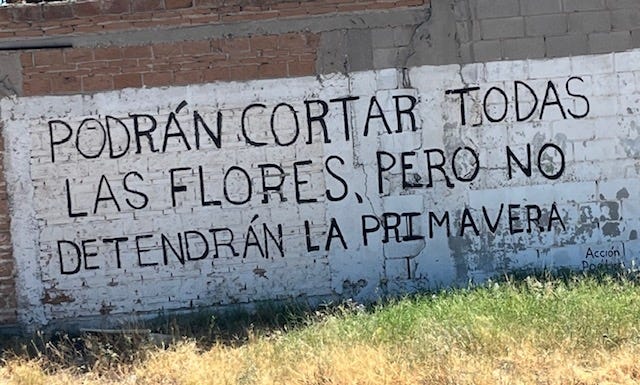Greeting from Presidio, Texas. I’m on the road this week, but I thought I’d share some photos and notes from this research trip thus far so you can get a glimpse into my new book project looking at climate, borders, and, ultimately, the emerging water wars.
In Ciudad Juárez, as my taxi was momentarily stopped, I saw this graffiti: “Podrán cortar todas las flores, pero no detendrán la primevera.” I didn’t get my phone out in time, and we sped forward. My destination, however, was a café only a block away, so I walked back and took the photo. It seemed like a perfect message for one of my final research trips for a book project delving into water wars and the border.
Before I saw that message, I stood at the top of the Stanton Street bridge and looked at the Rio Grande, which was just a sludgy, muddy trickle. On the U.S. side I could see the distant silhouette of a soldier—probably with the Texas National Guard—holding an automatic rifle. You can barely make him out in the above picture. With the combination of walls, barriers, Border Patrol, military, and the Texas Department of Public Safety, the border never seemed more militarized on the 30th anniversary of Operation Hold the Line. On the Mexican side, unseen in the photo, a family walked along the border, underneath the mural of Che Guevara, presumably en route to request asylum.
On the Mexican side, there was also an impressive law enforcement display. As soon as I crossed, I looked for shade near the immigration detention center where a fire killed 40 people in March. Moments later a long row of fire trucks and municipal police came sirens blaring. I had no idea what was going on until someone told me it was a massive drill. A police truck stopped, and an agent pulled out a medium-size drone. They were close by, but I didn’t get a picture for fear that the police would get testy. I did, however, get a picture of the construction site of the Torre Centinela, a 20-story surveillance center being built in the center of Ciudad Juárez. (We hope to do a story detailing this more soon for The Border Chronicle, so stay tuned!)
In this, it is interesting to contrast the focus on surveillance infrastructure, especially as water issues become more prominent. The above picture that I took on my way to Presidio shows a large Customs and Border Protection aerostat outside of Marfa, Texas. When high in the sky, and with the help of high-tech cameras, these blimps can monitor a large stretch of land.
This is a picture from a visit I had with the International Boundary and Water Commission in El Paso at the American Dam. This is where Texas, New Mexico, and Chihuahua meet. In the background you can see the wall privately funded by a now legally-challenged organization called We Build the Wall. I will have more to write on my interesting meeting with the IBWC and future water tensions between the United States and Mexico.
To see some of these water issues firsthand on the Mexican side, I visited the Valle de Juárez (right outside the city), where my guide, Alejandro González—an artist from the organization Defensa del Rio Bravo (the Defense of the Rio Grande)—showed me where a large U.S. energy company, Sempra Infrastructure, had set up near the border wall (which you can barely make out in the background) in San Isidro. As you can see on the blue sign, the first value they state is “hacemos lo correcto,” or “we do the right thing.”
A little down the border, under the Tornillo-Guadalupe International bridge, the river seemed to have dried up completely.
At the Museo Regional del Valle de Juárez, Professor Ernesto Robles shows me a picture of the river from the 1970s. He talked about weekends he spent there with his family, swimming and fishing.
Despite all this, this picture is at the Okupa Cultural Valle de Juárez, a cultural center focused on youth that has only been open for a few months in the nearby border town of Caseta. In the photograph above are (from left) David Morales, Abigail Morales, Ivonne Ochoa, and Alejandro González (my guide). When I took this picture, I thought of that graffiti wisdom I saw in Ciudad Juárez, “They can cut down all the flowers, but they can’t stop the spring.”
The church at dusk near the cultural center in Caseta.
And now I’m in Presidio. I took this picture last night at dusk. The sun sets over the Border Patrol housing in the town. Today (Thursday), I’m going to spend time at the Rio Conchos in Mexico. I’ll share those photos next time!
Read more: Read More




